Native cow varieties of India
Contents
Why make this list?
A recent investigation by the Tehelka magazine[1] arrived at the conclusion that in 10 years, India will be forced to start importing milk, and that Indian cow will cease to exist. Why? Due to several reasons:
- India, over the past few decades, imported several exotic cow varieties to gain a boost in milk production. In Punjab, for example, 80% of the state's one lakh stray cattle are exotic breeds. These breeds theoretically produce a lot of milk, but are not well-adapted to Indian conditions.
- 69% of Indian cows are owned by the economically poor strata of the society. These folks cannot afford to house these exotic breeds in regulated climate conditions.
- The government has significantly mismanaged cow breeding. The average milk yield per animal in India is just 3.2 kgs, compared to a global average of 6.6 kgs. The dairy policy and outlook is highly outdated and needs to be replaced with modern, evidence-based thinking.
India has 37 pure cattle breeds. Five of these — Sahiwal, Gir, Red Sindhi, Tharparkar and Rathi — are known for their milking prowess. A few others, such as Kankrej, Ongole and Hariana, belong to dual breeds that have both milch and draught qualities; ie, they are good plough animals. The rest are pure draught breeds.
Source: Tehelka[1]
Indigenous cattle varieties
Data derived from the following sources:
- Report on National Commission on Cattle[2]
- List of cattle breeds Article on Wikipedia
- Images were downloaded from various sources, primarily Wikimedia Commons and Gougram.org's Picasa page
| Name | Average yield/lactation | Geographical range | Description (Source)[2] | Image | Other names |
|---|---|---|---|---|---|
| Gir | 2000-6000 kg | Saurashtra, Gujarat | This breed produces the highest yield of milk amongst all breeds in India. Has been used extensively to make hybrid varieties, in India and in other countries like Brazil. |  |
|
| Sahiwal | 2000-4000kg | Punjab, Uttar Pradesh, Haryana | The cow is easily identifiable by its prominent red color | 200px | |
| Red Sindhi | 2000-4000kg | Originated in Sindh, Pakistan. Now widespread. |  |
||
| Rathi | 1800-3500 kg | Bikaner, Rajasthan, Haryana, Punjab | Type of a w:Zebu cattle. |  |
Bos primigenius, Bos taurus, Bos indicus |
| Tharparkar | 1800-3500 kg | Sindh (Pakistan), Kutch, Jaisalmer, Jodhpur | Bullocks are slow workers. Cows are good milkers. Same species as Rathi. |  |
Bos primigenius, Bos taurus, Bos indicus |
| Deoni | Marathwada, Maharashtra |  |
|||
| Hariana | 1000-2000 kg | Haryana, Uttar Pradesh, Bihar, Rajasthan | Bullocks are useful for ploughing and transport. Cows are good milkers. |  |
|
| Kankrej | 1500-4000 kg | Bhuj, North Gujarat, Rajasthan | Bullocks are strong and hard-working. Among the largest cattle breeds in India |  |
|
| Ongole | NA | Guntur, Ongole in Andhra Pradesh | Bullocks are useful for ploughing and cart-work / transport. Cows are fair milkers. Has natural resistance to both foot and mouth disease and mad cow disease | 200px | |
| Red Kandhari | NA | Marathwada, Maharashtra. | Bullocks are good draught animals. Cows are good milkers. |  |
|
| Nimari | NA | Khandwa, Madhya Pradesh | This is a dual purpose milk and draught breed. Animals are copper colored, with patches of white. | 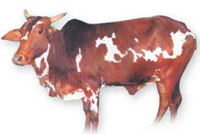 |
|
| Malvi | NA | Madhya Pradesh, Rajasthan | Bullocks are useful for ploughing. Cows are average milkers. |  |
|
| Dangi | Western Maharashtra | Especially good for heavy rainfall areas for draught purpose. |  |
||
| Khillari cattle | Southern Maharashtra, Northern Karnataka | Bullocks are hardy and well-known for being fast in work. |  |
||
| Amritmahal | 1000-1200 kg per lactation | Karnataka | Bullocks are well-known for draught power and endurance. | 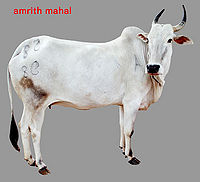 |
|
| Hallikar | Hassan, Mysore, Tunkur districts of Karnataka | Draught breed both used for road and field agricultural operations. Closely related to Amrit Mahal. However, are much thinner and produce low yields of milk. | 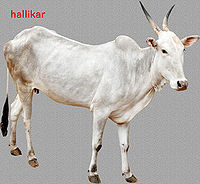 |
||
| Kangayam | Coimbatore, Tamil Nadu | Bullocks are strong draught animals. Their skin is very strong and tight. | 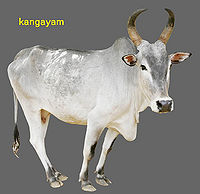 |
||
| Nagori | Nagore, Rajasthan | It is an excellent draught breed. Bullocks are good for draught purposes. |  |
||
| Baraguru | Coimbatore, Tamil Nadu | Bullocks are good work animals. |  |
||
| Kenkatha | Banda, Uttar Pradesh, Madhya Pradesh. | Bullocks are small but fairly sturdy animals and good for cultivation in rocky areas. |  |
||
| Siri | Hills around Darjeeling and Sikkim. Originally from Bhutan. | This breed can stand the rugged conditions of the mountains very well. Bullocks are eagerly sought after for draught purposes (ploughing and transport) due to their reputed great strength. | 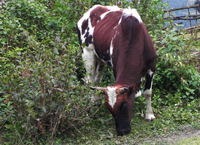 |
Nublaung (Bhutanese) | |
| Bachaur | Sitamarhi, Bihar. | Bullocks are used for draught purpose. Cows are poor milkers. |  |
||
| Kherigarh | Kheri, Uttar Pradesh. | The cattle of this breed are very active and thrive on grazing only. Bullocks are good for light draught and quick light transport. The cows are poor milkers. |  |
||
| Mewati | Rajasthan | Mewati cattle are in general sturdy, powerful and docile and are useful for heavy ploughing, carting and drawing water from deep wells. Cows are said to be good milkers. | |||
| Umblachery | Thanjavur, Tamil Nadu | It is a draught breed of the Zebu type, similiar to Kangayam but smaller. They are gray with white spots. The bulls are used in the sport of Jallikattu or bull-taming, which is different from the Spanish custom of matadors and running of the bulls. | 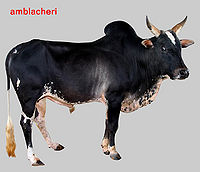 |
||
| Krishna Valley | Southern border of Maharashtra and Andhra Pradesh | Bullocks are powerful and good for heavy ploughing and slower draught purpose. Cows are fair milkers. |  |
Krishna Tira | |
| Ponwar | Pilbhit, Uttar Pradesh | Draught purpose. Cows are poor milkers. |  |
||
| Vechur | Kerala | Smallest cow breed in the world! Bullocks are mainly used for draught purpose. Cows are poor milkers. In the image alongside, the smaller cow is a 16 year old Vechur cow, while the larger cow is a 6-year old cross bred cow. |  |
||
| Malenadu Gidda | Coastal and hilly areas of Karnataka |  |
|||
| Kasaragod[3] | Kerala |  |
Additional reads
- A Pastolral Elegy Outlook Magazine. "Contrary to popular belief, indigenous breeds are a sturdier option than disease-prone crossbreds"
References
- ^ a b The Desi Cow, Almost Extinct Published in Tehelka on January 24, 2013.
- ^ a b Report on National Commission on Cattle Chapter 2. Accessed: 26th January, 2013
- ^ Kasaragod dwarf cattle may get native animal status Times of India, July 2012
Comments
blog comments powered by DisqusMore notes like this
|
|||||||||||||||||||||||||||||||||||||||||||||||||||||||||||||||||||||||||||||||||||||
Only 15 articles are shown in this list. A total of 64 articles in the database as of this moment. For the complete list, click on further results on the bottom right corner of the above table.
Semantic tags
- Browse all Semantic Tags associated with this page
- Find more pages and articles created by the community by clicking this link.
| Title | Native cow varieties of India | Article is on this general topic | Biodiversity data | Author | Gaurav Moghe |
|---|---|---|---|---|---|
| Specific location(s) where study was conducted | Not noted | General region where study was conducted | Not noted | State where study was conducted | Pan-India |
| Institutional affiliation | Not noted | Institution located at | Not noted | Institution based around | Not noted |
| Species Group | Animals | User ID | User:Gauravm | Page creation date | 2013/1/26 |
Share this page: